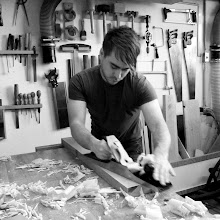The bikes made me think about how signifigant material selection can be in the both function and meaning of an object. It makes me marvel at the versatility of this particular material and deep knowledge of the maker required to pull something like this off.
It reminds me of the all wood airplanes that were developed by both the Germans and the Allies during World War II. The de Havilland Mosquito, for instance, was a mostly-wooden British bomber that at in spite of it's size was one of the faster airplanes in the world at the time. In the case of the Mosquito, these planes were built buy the expert hands of English carriagemakers and shipwrights. These planes could be made incredibly fast, inexpensively, and could spare precious raw material (metals) for other more critical tasks.
It reminds me of the all wood airplanes that were developed by both the Germans and the Allies during World War II. The de Havilland Mosquito, for instance, was a mostly-wooden British bomber that at in spite of it's size was one of the faster airplanes in the world at the time. In the case of the Mosquito, these planes were built buy the expert hands of English carriagemakers and shipwrights. These planes could be made incredibly fast, inexpensively, and could spare precious raw material (metals) for other more critical tasks.
On the other end of the spectrum are objects like Jeroen Verhoeven's Cinderella Table. This equally miraculous object was sculpted from a monolithic block of Carrera marble by CNC controled machining. While the utility of this table is unclear, it's one of those objects that makes me happy to know that it exists, and that someone had the chutzpah to actually make one.
Image via Artnet




2 comments:
Over the last few years I've seen several iterations of the wooden bike. What I think makes Mr. Sano's bike different from these is exactly what you point out: He understands wood. His use of ship building techniques to maintain continuous grain is what sets his apart from the CNC router crowd.
What I want to see is someone take bamboo bikes to Sano's level, and move beyond epoxy/lashing
Hey Ben,
For Sure.
I've seen a bunch wooden/bamboo bikes around Brooklyn, but most of them are primitive (shitty) looking. Sano, bike are complete opposite end of the spectrum (seamless). I seems that there's a lot of space in between for something better. On the other hand it's great to see people trying out alternative ways of making things.
A while back, some US guys were making an all wooden-frame super car called "the splinter" (http://www.joeharmondesign.com/). Of course wooden cars are nothing new (a lot of early cars were built that way, like carrages), but this one is built using all kinds of innovative plywood trickery. I'm not sure they've been put all the pieces together yet, but it's pretty cool, crazy, idea.
Post a Comment